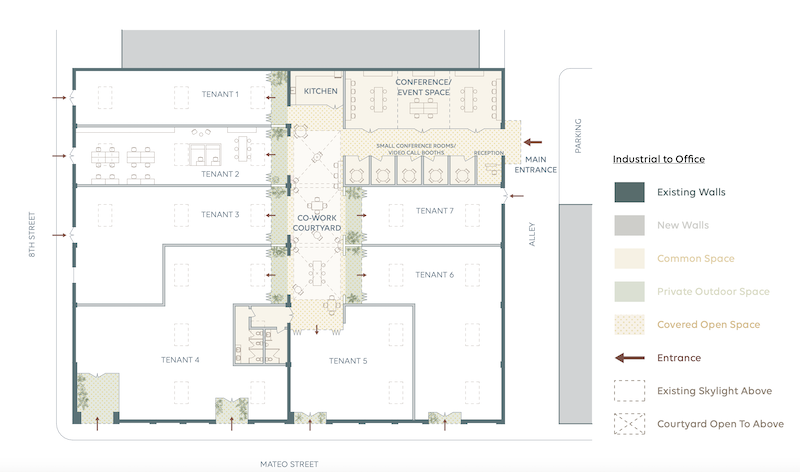The Los Angeles-based design firm Omgivning has released three white papers that propose new ways, post-COVID 19 pandemic, of looking at workplaces, multifamily, and urban reprogramming.
The firm’s ideas revolve around four unifying themes:
• Human-centric design
• Flexibility and adaptability
• Blended uses
• The relationship of space and economic context
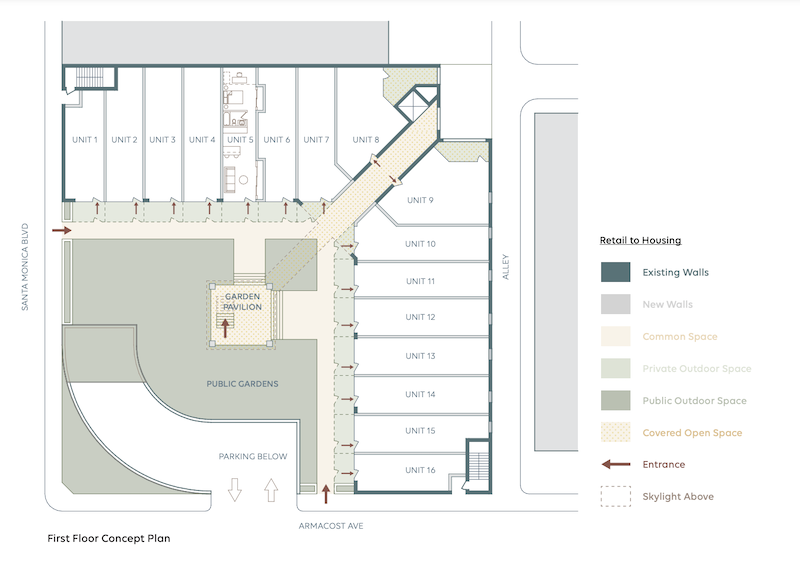
Big-box retail, which is under stress from online shopping, could be rethought for residential conversion with lots of open public areas.
Karin Liljegren, FAIA, IIDA, Omgivning’s founder and Principal, in 1999 worked on the very first projects under Los Angeles’ Adaptive Reuse Ordinance. Her firm’s recent white papers assume that changing social norms have created excess and unused capacity in the built environment. Those assumptions drive the various alternative concepts that Omgivning has devised, with an eye always toward reusing, as opposed to tearing down, existing buildings.
For example, Omgivning’s multifamily paper cites Preservation Positive, a report released by the LA Conservancy in 2020, that approximately three-fifths of Angelenos rent while the city remains in the middle of an ongoing housing crisis. “Rather than build itself out of this crisis, where the average cost to produce one new unit of subsidized affordable housing is at least $400,000, we should seek to find a more cost-effective, creative, and sustainable approach. Through enhancing the city's residential stock in existing buildings, we can help fill the gap toward achieving the City's housing goals.”
BREAKING DOWN THE MULTIFAMILY FORM
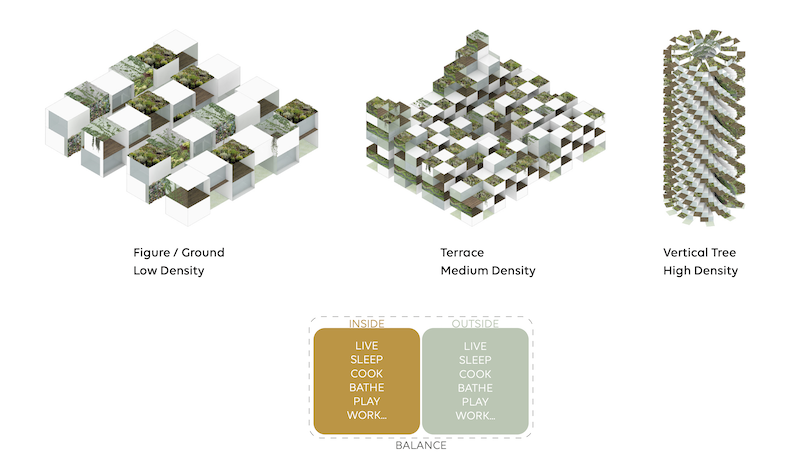
Multifamily buildings can achieve different density levels, depending on the amenities and biophilia included.
The multifamily paper offers four concepts:
• Humanizing the urban experience by providing features for existing urban apartment buildings that contribute to a greener, more porous city;
• Expanding unit types through designs that integrate diversity and flexibility into spaces for the inhabitants' various needs;
• Common spaces that emphasize a connection to nature, expand private work options in communal environments, and introduce on-site commerce; and
• Transforming interiors whose components are designed to be "both/and" solutions to meet multiple needs, as opposed to "either/or" that only allow for a single use.
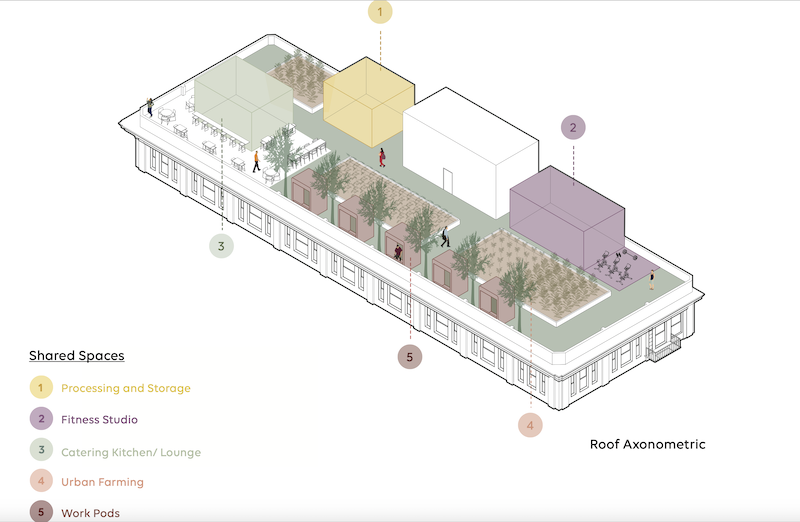
Shared and common spaces that could include roofdeck “work pods” are central to Omgivning's multifamily concepts.
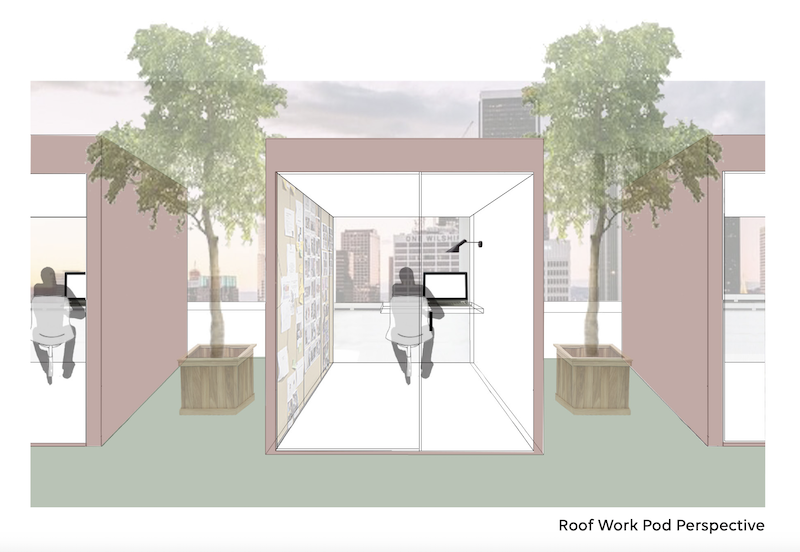
The paper deconstructs the multifamily form to incorporate open-ended light courts that allow natural light and ventilation to flow throughout. Its concepts expand the unit types within buildings to include two-story two-family, as well as private and “gather” zones.
“Opportunities also exist to create new experiences and interactions in areas once relegated to back of house,” the paper states, “or typically common to the street and sidewalk.” That might include relocating the mailroom to the front of the building and adding refrigerated boxes and larger parcel rooms. “Even the simple act of picking up mail presents a greater chance of engaging with neighbors.”
PODS FOR DIFFERENT USES
Omgivining is a big advocate for incorporating “pods” into its reimagining of buildings for privacy and utility. Pods are part of one of the firm’s alternate multifamily unit types. And Omgivning’s workplace paper presents three pod types that accommodate a broad range of needs:
The View Pod, designed for maximum resilience that supports unexpected shelter-in-place requirements. Enclosed on all sides with one main opening directed towards a chosen view, these pods could face exterior windows or a common open space within the office. In its workspace scenario, The View ensures privacy and sound isolation, while remaining visually connected to elements beyond. The sleep scenario can host a mattress for an overnight stay.
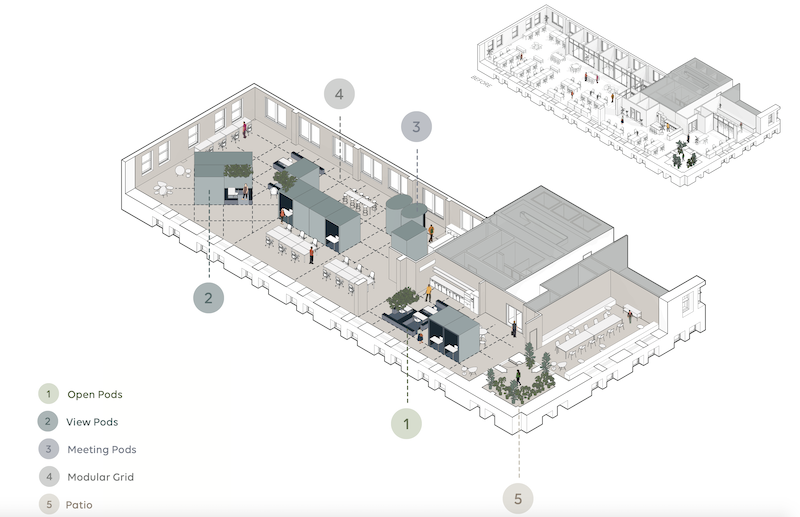
Omgivning reimagines the workplace with different kinds of intimate spaces, such as its “work-meet” pod that allows for privacy and collaboration.
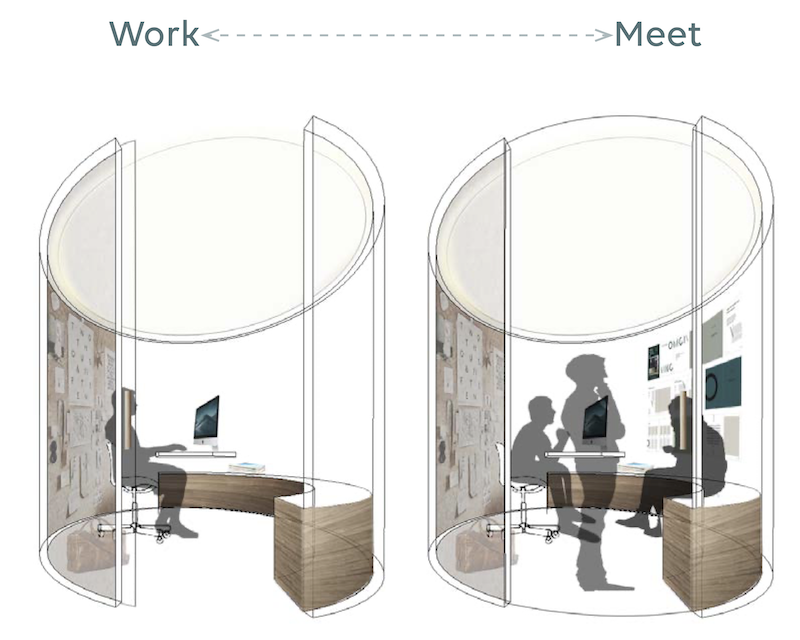
The Meeting Pod, which provides flexibility for open or enclosed meetings. Its circular footprint provides acoustic privacy for video calls and to aid in focus. Built-in millwork offers dual functions for seating and storage. Integrated lighting and tackable surfaces present a clean background for personalization and work-based pin-ups.
The Open Pod, which provides a modular footprint with varying barrier preferences. It defines an individual space while staying visually connected to the communal space. The barrier preferences are adjustable to an open or enclosed layout, based on the occupant's needs. Greenery, suspended from above or in planters, can be used to define zones and remind inhabitants to prioritize wellbeing. The Open Pod provides built-in lockers, open shelving and the option for a height-adjustable desk.
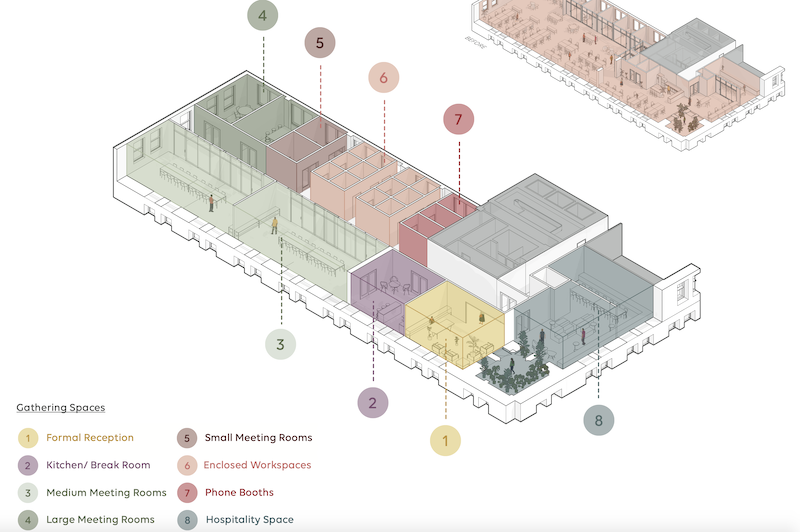
The workplace needs places where employees can still congregate safely.
The workplace paper also offers reuse concepts for gathering spaces and for better infection control, the latter of which helps employers assess workers’ needs by developing targeted protocols that focus on human impacts.
REVIVING TIRED RETAIL AND WAREHOUSE SPACE
In its paper on reimagining urban reprogramming, Omgivning cites experts who anticipate that 90% of real estate development over the next decade will focus on renovation and resuse, rather than new construction.
To that end, this paper proposes ways to transform struggling strip malls (there are 675 malls in Los Angeles alone), big-box retail (using an existing vacant 150,000-sf Costco in L.A. as its starting point), light-industrial warehouses, and urban ground-floor commercial space.
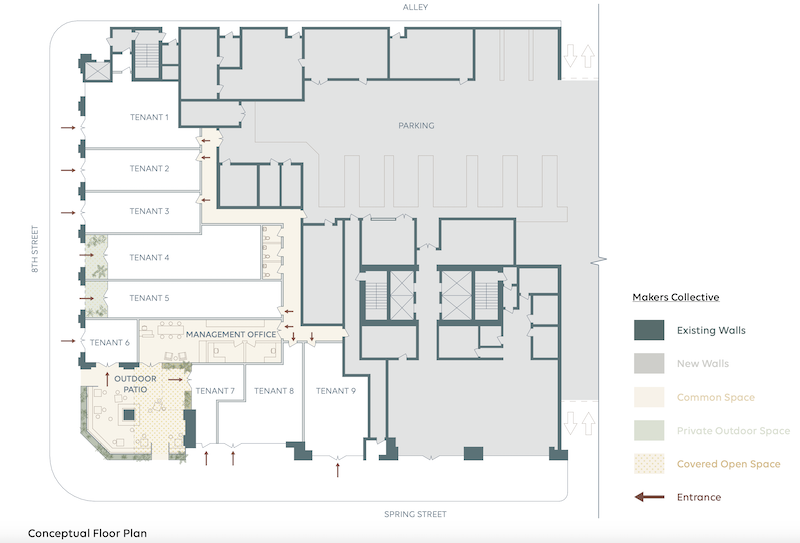
Light industrial space could be converted to leasable maker spaces.
Its vision for converting retail space to housing includes one configuration showing a mini-mall with the capacity to hold 30 600-sf affordable residential units, each outfitted with work-from-home capabilities, and an outdoor patio or courtyard.
Omgivning’s reuse of light industrial space includes an office concept that’s organized around a centrally located courtyard that provides users with cross ventilation, natural light, and connection to green outdoor space. It also conceived a live-work concept that carves up the building into smaller, more affordable lofts that are linked through outdoor courtyards, and are circulation-rich with greenery.

Restaurants and offices share some common traits that could be combined for converting ground-floor retail.
Transforming ground-floor retail could encompass what Omgivning calls a Makers Collective concept, where a master tenant, or even an existing building management company, can lease a large space and subdivide it into smaller units for individuals or small startups. The program consists of shared space to house equipment needed by the tenants, and a shared space for events and periodic showcases of the community’s products. An outdoor lounge and garden provide a communal gathering space.
Omgivning even goes so far as to suggest a restaurant/office hybrid concept that reduces each footprint by sharing the varied seating arrangements within a restaurant to accommodate individual and collaborative work.
Related Stories
Adaptive Reuse | Jan 18, 2024
Coca-Cola packaging warehouse transformed into mixed-use complex
The 250,000-sf structure is located along a now defunct railroad line that forms the footprint for the city’s multi-phase Beltline pedestrian/bike path that will eventually loop around the city.
Adaptive Reuse | Jan 12, 2024
Office-to-residential conversions put pressure on curbside management and parking
With many office and commercial buildings being converted to residential use, two important issues—curbside management and parking—are sometimes not given their due attention. Cities need to assess how vehicle storage, bike and bus lanes, and drop-off zones in front of buildings may need to change because of office-to-residential conversions.
K-12 Schools | Jan 8, 2024
Video: Learn how DLR Group converted two big-box stores into an early education center
Learn how the North Kansas City (Mo.) School District and DLR Group adapted two big-box stores into a 115,000-sf early education center offering services for children with special needs.
Affordable Housing | Dec 14, 2023
What's next for affordable housing in 2024?
As 2023 draws to a close, GBBN’s Mary Jo Minerich and Amanda Markovic, AIA sat down to talk about the future. What’s next in terms of trends, technology, and construction of affordable housing?
MFPRO+ News | Nov 21, 2023
Underused strip malls offer great potential for conversions to residential use
Replacing moribund strip malls with multifamily housing could make a notable dent in the housing shortage and revitalize under-used properties across the country, according to a report from housing nonprofit Enterprise Community Partners.
Office Buildings | Nov 10, 2023
3 important early considerations for office-to-residential conversions
Scott Campagna, PE, Senior Director of Housing, IMEG Corp, shares insights from experts on office-to-residential conversion issues that may be mitigated when dealt with early.
Adaptive Reuse | Nov 1, 2023
Biden Administration reveals plan to spur more office-to-residential conversions
The Biden Administration recently announced plans to encourage more office buildings to be converted to residential use. The plan includes using federal money to lend to developers for conversion projects and selling government property that is suitable for conversions.
Government Buildings | Oct 23, 2023
Former munitions plant reimagined as net-zero federal workplace
The General Services Administration (GSA) has embraced adaptive reuse with Building 48, an exciting workplace project that sets new precedents for how the federal government will approach sustainable design.
Esports Arenas | Oct 10, 2023
Modular esports arena attracts more than gamers
As the esports market continues to grow to unprecedented numbers, more facilities are being developed by universities and real estate firms each year.
Luxury Residential | Oct 2, 2023
Chicago's Belden-Stratford luxury apartments gets centennial facelift
The Belden-Stratford has reopened its doors following a renovation that blends the 100-year-old building’s original architecture with modern residences.


